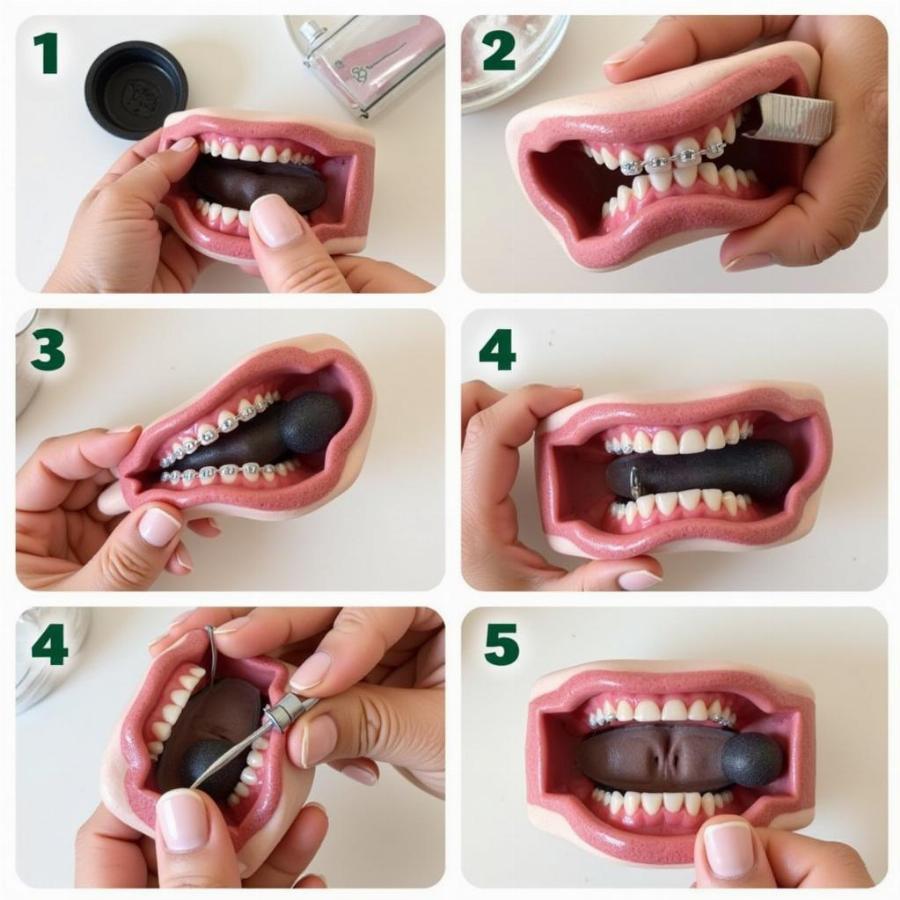Dog teeth braces, also known as canine orthodontics, are becoming increasingly common in the world of pet care. While it may seem like a cosmetic procedure, there are valid medical reasons why your veterinarian might recommend braces for your furry friend. This article will delve into everything you need to know about dog teeth braces, from the reasons behind their use to the process and aftercare.
Understanding the Need for Dog Teeth Braces
Just like humans, dogs can develop dental problems that affect their bite alignment. These misalignments can lead to a range of issues, impacting their ability to eat properly and potentially causing pain and discomfort.
Some common reasons why a dog might need braces include:
- Malocclusions: This refers to misaligned bites, such as overbites, underbites, or crossbites. These conditions can make it difficult for your dog to chew food effectively, leading to digestive issues and even nutritional deficiencies.
- Crowding: When there isn’t enough space in a dog’s mouth for all of their teeth, it can cause crowding and misalignment. This can result in difficulty cleaning their teeth, increasing the risk of periodontal disease.
- Injury: Trauma to the mouth, such as a fractured jaw or tooth, can lead to misalignment and necessitate orthodontic intervention.
The Benefits of Dog Teeth Braces
Addressing dental misalignments with braces offers numerous benefits for your canine companion:
- Improved Chewing Ability: Properly aligned teeth allow for efficient chewing, improving digestion and nutrient absorption.
- Pain Relief: Malocclusions can cause pain and discomfort while chewing, leading to decreased appetite and weight loss. Braces can alleviate this pain and improve your dog’s overall quality of life.
- Reduced Risk of Dental Disease: Straight teeth are easier to clean, reducing plaque and tartar buildup, and minimizing the risk of periodontal disease, which can lead to serious health problems if left untreated.
- Enhanced Appearance: While primarily a medical procedure, braces can also improve your dog’s appearance, especially in cases of severe misalignments.
The Dog Teeth Braces Process
If your veterinarian recommends braces for your dog, a veterinary dentist will conduct a thorough examination, including X-rays, to determine the best course of treatment. The process typically involves the following steps:
- Dental Evaluation: A comprehensive exam will assess the severity of the misalignment and determine the appropriate type of braces.
- Molding: Impressions of your dog’s teeth will be taken to create custom-fitted braces.
- Brace Placement: The braces are typically attached using dental cement and adjusted periodically.
- Monitoring and Adjustments: Regular checkups will be scheduled to monitor progress and make any necessary adjustments to the braces.
- Brace Removal: Once the desired alignment is achieved, the braces will be removed, and retainers might be recommended to maintain the new position.
 Dog Teeth Braces Procedure
Dog Teeth Braces Procedure
Living with Dog Teeth Braces
While your dog adjusts to their braces, you can take certain measures to make the process smoother:
- Soft Food Diet: Offer soft food to minimize discomfort while chewing.
- Oral Hygiene: Maintain good oral hygiene by brushing your dog’s teeth regularly with a pet-safe toothpaste.
- Regular Checkups: Attend all scheduled appointments to monitor progress and address any concerns.
Are Dog Teeth Braces Right for Your Dog?
The decision to pursue dog teeth braces is a personal one, best made in consultation with your veterinarian. They will consider factors such as the severity of the malocclusion, your dog’s age and overall health, and the potential risks and benefits of the procedure.
Seeking Professional Guidance
If you notice signs of dental problems in your dog, such as difficulty eating, drooling, or pawing at their mouth, it’s crucial to seek veterinary attention. Early detection and intervention can prevent further complications and ensure your furry friend maintains a healthy, happy smile.
FAQs About Dog Teeth Braces
Q: How long do dogs typically wear braces?
A: The treatment duration varies depending on the complexity of the case, but it typically ranges from a few months to a year.
Q: Is the procedure painful for dogs?
A: Brace placement and adjustments are generally well-tolerated by dogs. However, your veterinarian may recommend pain medication if needed.
Q: Are there any risks associated with dog teeth braces?
A: As with any procedure, there are potential risks, such as gum irritation or tooth damage. Your veterinarian will discuss these risks and take precautions to minimize them.
Looking for More Information?
For in-depth articles on specific dental conditions in dogs, check out our resources on overbite in dogs, underbites in dogs, and htf tooth on a dog.
About Beaut Dogs
Beaut Dogs is your trusted source for all things dog-related. We provide expert advice and information to help you care for your canine companion. For personalized guidance on dog teeth braces and other dental care needs, contact us at [email protected].